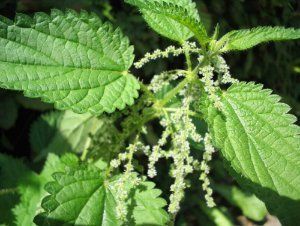Description: Stinging Nettle, scientifically known as Urtica dioica, is a perennial herbaceous plant belonging to the Urticaceae family. Widely distributed across Europe, Asia, and North America, this plant is known for its characteristic stinging hairs on the leaves and stems. Despite its stinging nature, Stinging Nettle has been historically valued for its medicinal uses, and it serves various ecological roles.
Habitat and Distribution: Stinging Nettle thrives in a variety of habitats, including woodlands, meadows, and disturbed areas. It is often found in nutrient-rich soils and can tolerate both sunny and shaded conditions. Native to Europe, Asia, and North America, it has naturalized in many other regions.
Physical Features: Leaves: Stinging Nettle leaves are opposite, serrated, and heart-shaped with stinging hairs that contain irritating chemicals. These hairs can cause a stinging sensation and skin irritation upon contact.
Stems: The stems are square in cross-section and also bear stinging hairs.
Flowers: Inconspicuous greenish flowers are arranged in long, dangling clusters.
Ecological Significance:
Stinging Nettle plays several important ecological roles:
- Habitat Provider: The dense stands of Stinging Nettle provide habitat and shelter for various insects and spiders.
- Food Source: The leaves are a food source for butterfly caterpillars, such as those of the Small Tortoiseshell.
- Nitrogen Accumulator: Stinging Nettle is known for accumulating nitrogen, contributing to soil fertility.
Cultural Uses:
- Medicinal: Despite its stinging hairs, Stinging Nettle has a long history of medicinal use. It is believed to have anti-inflammatory properties and is used for various ailments, including allergies and arthritis.
- Culinary: Young, tender shoots of Stinging Nettle can be cooked and consumed as a nutritious green vegetable. The leaves are rich in vitamins and minerals.
Control and Management:
- Protective Clothing: When working with Stinging Nettle, wearing protective clothing such as gloves and long sleeves can prevent skin irritation caused by the stinging hairs.
- Mechanical Control: Regular mowing or cutting can help control the growth of Stinging Nettle. However, this may need to be done consistently as the plant regenerates from its rhizomes.
- Cultural Practices: Improving soil fertility may help manage Stinging Nettle, as it thrives in nutrient-rich soils. Balancing soil nutrients can discourage its growth.
- Herbicides: Selective herbicides labeled for broadleaf weed control can be used to manage Stinging Nettle in specific areas. Careful application is necessary to avoid harm to desirable plants.
Preventing Spread:
- Early Detection: Regular monitoring and early detection of Stinging Nettle can prevent its spread. Prompt removal of young plants can be effective.
- Limiting Disturbance: Minimizing soil disturbance in areas where Stinging Nettle is prevalent can help prevent the germination of seeds and the spread of rhizomes.
- Promoting Native Vegetation: Encouraging the growth of native vegetation can help outcompete Stinging Nettle and maintain ecological balance.
In conclusion, while Stinging Nettle has ecological significance and cultural uses, its stinging hairs and ability to form dense stands make it a concern in certain environments. Integrated control methods, including protective measures, mechanical and cultural practices, and, if necessary, targeted herbicide application, can help manage Stinging Nettle and mitigate its impact on desired ecosystems.



